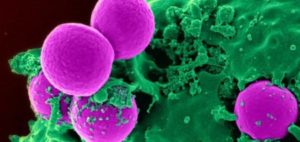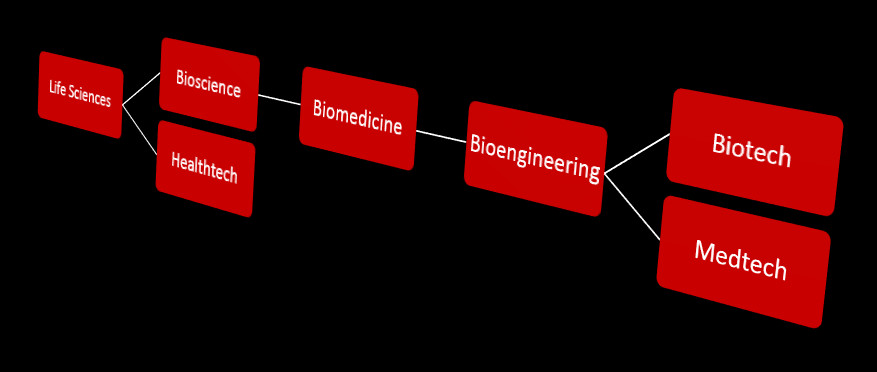Working across disciplines can be confusing, not only due to professional jargon but also due to basic terminology being used interchangeably by different people or media sources. This is very true in the biomedical sphere. After a recent brief exchange with someone who is interested in technology applications in healthcare and life sciences, I was stimulated to propound some of my interpretations of the following terms: life sciences, bioscience, biomedicine, bioengineering, biotechnology, medtech and healthtech. I enjoy words and languages from a practical perspective. So, let’s see how it goes.
Life sciences
Unsurprisingly, life sciences are concerned with the study of living organisms and life processes. This is the broadest term of the ones explored here. It includes bioscience, medicine and can be stretched further to disciplines such as anthropology and social sciences. If unsure, the broadest term is usually the safest bet in conversation but also the most imprecise and, hence, requires more context to establish its intended meaning.
Bioscience
Bioscience gives us a little more definition than life sciences. It refers to all biological sciences, i.e. the study of living organisms and vital processes. This doesn’t really sound much different from the above. What people usually have in mind, in my experience, are disciplines relating to microbiology, virology, plant, animal and human biology. You can see how we are edging closer to medicine, which brings me to…
Biomedicine

Biomedicine is a fusion of biology and medicine where the ‘bio’ focusses on the study of human biology, with relevant cross-overs to microbiology and other areas of biology as well as biochemistry, in order to understand medical conditions. A poster child (and my personal favourite) is immunology, as this biomedical discipline studies the human immune system, including its interaction with microorganisms or viruses and the inherent genetics and biochemical processes.
Biomedicine is the science that underlies bioengineering, bio- and medtech, which all address medical diagnostics, prevention and therapy. The ‘tech’ disciplines are essentially the practical applications of the study of biomedicine. They use biomedical insights and research, but their focus is slightly different. That is why we’re now getting into a real mess when it comes to delineating practical definitions that help people communicate clearly, as we find a huge overlap in the use of these words.
Bioengineering
As indicated above, we are now drifting away from the focus on scientific study and over to its practical application. Bioengineering relies on biomedical knowledge and ultimately covers both bio- and medtech. As the ‘engineering’ part makes clear, the focus is on constructing something and particularly makes the problem-solving aspect inherent in engineering disciplines more obvious than the ‘tech’ words.
Let’s now leave the collective terms and get more specific. Sure, we could split up bio- and medtech into specialist branches, but we’ll just make them endpoints here.
Biotechnology

Biotech exploits or manipulates molecular mechanisms in cells (i.e. the smallest building blocks of life). The goal is often to induce a living organism to behave a certain way or produce something for academic or commercial purposes. Genetics play a huge role because of their fundamental function in cell biology. Genetic engineering, for example, has been used in plants to create pest-resistant crops. It is routinely used in microorganisms like bacteria or yeast for research purposes. Gene therapy in humans is a hot topic and growing market. The to date most expensive ‘drug’ at over $2M a shot is a gene therapy for a rare disease. Another recent biotech milestone is Pfizer-BioNTech’s mRNA COVID-19 vaccine.
Note that you see ‘biopharmaceutical’ crop up as a term as well due to the overlap in drug development. It is a catch-all to acknowledge that drugs are developed using traditional pharmaceutical methods (with a heavy base in chemistry) as well as biotechnology.
Medtech

The focus of medical technology is on medical engineering, which involves biotech application in the name of medicine. (Now, if that’s not a grey area right there.) Medtech encompasses all sorts of medical devices such as body implants, external devices like blood pressure monitors and also prosthetics. It includes all the tech we see in hospitals like ECG, blood cell counters or drug dosing devices. I’d also class natural and synthetic biomaterials as medtech, as these are generally developed for the purpose of medical diagnostics or therapy. Along those lines, diagnostic test kits like the COVID-19 genetic and serological kits would also come under medtech.
Healthtech
Now, here is a bit of a personal pet peeve; although I’m coming round slowly to some degree. I used to understand healthtech as more of a popular or commercial term because that is the context in which I have usually seen it used, especially regarding wearables like step counters or smartwatches. Then the question arises, why we don’t just use the term ‘medtech’ for those, as I don’t see medtech confined to hospital walls. ‘Healthtech’ gives the impression that people aren’t convinced those personal monitoring devices are of medical value; or maybe there is a psychological element. If you call it ‘medtech’, it implies you’re ill or something could be wrong. This ignores the fact that medtech’s purpose may easily extend to prevention. I suppose it is easier to sell a consumer device when people can frame it in their minds in terms of health enhancement instead of protection from illness. Nevertheless, there is no need for yet another term that further confounds the blurry lines in Bio-Babel. Especially with healthcare moving more and more towards patient-centred and remote care, trying to distinguish between medtech and healthtech will become increasingly difficult.
However, the reason I’m coming round to ‘healthtech’ as a helpful additional term is its use in the context of healthcare IT needed to deliver health services such as administration or communication software like database management and security systems, dedicated telehealth apps or data analytics tools.
Summary
The ‘problem’ with bioscience disciplines is that they inevitably overlap, especially the closer we move towards medicine and real world applications. Getting too hung up on definitions is not helpful. At the same time, having too many words for the same thing is confusing.
We can analyse words to death. This wasn’t my objective here. The purpose of words is to help us communicate. I have tried to take a practical approach to the terms above based on my experience in an attempt to declutter the confusion. Whilst the flowchart below summarises my presented views neatly, reality is less clear-cut. That is something the biomedical scientist in me has learnt to accept and appreciate.

Note that, whilst I have outlined a flow from the sciences to engineering and technology, with sciences delivering the underlying knowledge and principles, it is obviously not a one-way street. Technology helps make scientific discoveries, which in turn improve further technological advances.